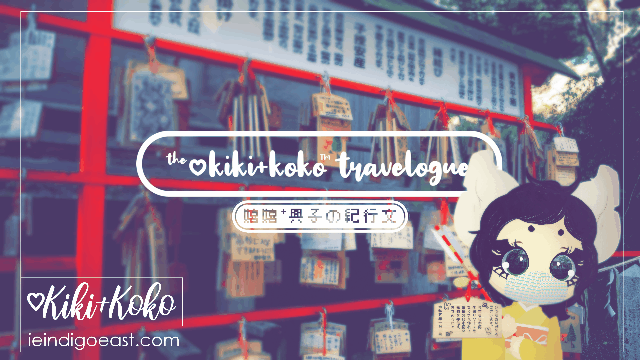皆様、こんにちにゃあぁ!Welcome to Kiki+Koko: Let’s NihonGO!! Online! ここにも そこにも どこにでもーHere, there, and everywhere, teaching you Japanese language and culture, we’re your hosts, Kiki and Koko! This lesson, we’re delving into the titular vocabulary words! We’re here to give you trustworthy, there, useful tips and tricks to understanding and use Japanese language that may not be obvious or explained thoroughly in textbooks or class. We’re everywhere you want to be! But, we’re here to lead you each step of the way through your Japanese language learning journey to your goals. Though there are some concepts that are more advanced that we continue to mention briefly in order to not cause too much confusion, we’re here to explain the basic functions that are usually explained in a way that may make sense to students, but end up actually causing more conversational confusion in future. Before we revise the previous demonstrative pronouns, we’ll be having a look at demonstrative adverbs which will assist greatly in both exemplifying usage as well as showing their relation to each other as demonstratives. Whether you’re travelling Japan or just want to communicate with friends in Japanese, these will be quite useful to your daily conversational and essential usage.
 Sometimes Japanese grammatical and linguistic concepts are taught in a way that may seem to make sense as a Japanese teacher, but end up actually obscuring the true meaning and usage of a word. And, sometimes, in trying to make lessons simpler, it obscures the important usages that make things like demonstratives so useful. Textbooks and teachers may often describe こそあど言葉, kosoado kotoba, demonstratives as relating to distance in general, but that’s not the full story. As we mentioned and demonstrated in the previous lessons—which we recommend you have a look at as these lessons build upon each other and will really help you not only learn these words, but understand their usage—demonstratives generally relate to the distance of something to the speaker and to the listener. We do mention these concepts throughout the lessons, but we think it’s something very important to understand, as again, many teachers explain this idea as relative distance to oneself in general rather than a sort of relational distance that differs between distance from speaker to distance from the listener to distance from both—as well as other more advanced intangible concepts.
Sometimes Japanese grammatical and linguistic concepts are taught in a way that may seem to make sense as a Japanese teacher, but end up actually obscuring the true meaning and usage of a word. And, sometimes, in trying to make lessons simpler, it obscures the important usages that make things like demonstratives so useful. Textbooks and teachers may often describe こそあど言葉, kosoado kotoba, demonstratives as relating to distance in general, but that’s not the full story. As we mentioned and demonstrated in the previous lessons—which we recommend you have a look at as these lessons build upon each other and will really help you not only learn these words, but understand their usage—demonstratives generally relate to the distance of something to the speaker and to the listener. We do mention these concepts throughout the lessons, but we think it’s something very important to understand, as again, many teachers explain this idea as relative distance to oneself in general rather than a sort of relational distance that differs between distance from speaker to distance from the listener to distance from both—as well as other more advanced intangible concepts.
Though it may seem obvious to grammar aficionados, words like ‘here’ and ‘there’ are actually adverbs! The reason why we mention this is because it always feels like they’re prepositions. But, when we look at other words in Japanese, it makes sense, because words like ‘close’ and ‘far’ change their adjective form to an adverbial form. Even though that concept is for another lesson, it’s something interesting to keep in mind.

Though, it’ll be important to know this lesson, in order to understand that lesson, and this lesson to understand that one, you’ll also need to start with the previous lessons concerning question words. But, no worries, they’re linked within the page.
If you haven’t already, we suggest you have a look at our basic Japanese question words, or 疑問詞, gimonshi, lessons, before this one. Oddly enough, they have important aspects in common, but this lesson may assist you in their usage as well as vice versa. But, those who read the previous lesson will probably feel vindicated with a useful callback to a previous lesson. If you also are sure to have delved into the previous demonstrative lessons, then you may realise that one of the 疑問詞, gimonshi, to which we’ll be referring back this lesson, actually follows the pattern we laid out for you in Here, There, and Everywhere| Basics of Japanese Demonstratives | PART 1, then further exemplified in Here, There, and Everywhere| Basic Japanese Demonstratives| Pronouns | PART 2. There is definitely a method to the madness! That’s why—even though it’s useful and encouraged to go off and learn from our lessons concept by concept as you have questions or intrigue— it’s important to go back and learn lesson by lesson chronologically in order to understand the concepts we’re building upon. However, you can learn at your own pace and use whichever method works for you! (But, again, the lessons build upon each other, so you’ll most likely find things a bit more cohesive when you learn it chronologically.)
To Lead a Better Life, [You] Need [Your][Demonstrative Adverbs]…
Why are these adverbs (and this lesson) important?

Be sure you know how to make question sentences as well as basic sentences and particles found in the subsection of the Essentials section dedicated to grammar
As we want to reiterate from previous lessons, demonstratives are essential to everyday speech. And, in order to properly understand the concept, this lesson will be essential to understanding demonstratives and also assist you in sentence structure and other grammatical concepts. After seeing the similarity in usage between the other 指示語, shijigo, and the 疑問詞, gimonshi, included in the 指示語、shijigo, it should hopefully add to and clarify the previous concepts as well as the new adverbial ones.
Perhaps you’re someone who only wants to know just enough Japanese language to get by, and in that case, understanding this concept is still all the more important. Now, when you use a digital translator or phrase book, this concept isn’t properly conveyed, and can leave you as the listener or the other party as the listener confused as to your meaning. And, conveying meaning is very important in communication! In fact, that’s pretty much the whole of communication itself.
Let’s picture a specific situation that may seem simple at first, but if you’re relying on phrasebooks or digital translation, then it may only cause confusion. Let’s say your coworker has brought a useful and dare-we-say maybe even stylish Kiki+Koko: Let’s NihonGO!! notebook from Indigo East and they’ve misplaced it in the classroom or office. They call out to you, sitting across the room, way over there in comparison.
すみませんが、私の ノートがどこにあるか知っていますか?
sumimasenga,watashi no nooto ga doko ni aru ka shitteimasuka?
Pardon, but do you know where my notebook is?
You nod, thinking you may know from your phrasebook how to communicate this idea. You know the notebook is actually right next to your coworker underneath another paper. In relation to you, it’s quite far away. Mistakenly, you say:
✖ はい!あそこですね。
✖はい! asoko desu ne.
✖Yes, it’s way over there!
Your coworker looks off to another desk that’s far away from both of you.
フーム、見られません。
fuumu, miraremasen.
Hmm, I don’t see it.
You point and repeat yourself, but the idea still doesn’t come through. And, perhaps the notebook will be lost forever under that one piece of paper. Sure, you could walk over and get it for them, or say it’s next to them, but what would make more sense is just saying it correctly which will save you and everyone time and hassle. ⏪Let’s rewind!!⏪
After using your vast and amazing knowledge after learning with us, you say, instead:
はい!そこですね。
hai! soko desune.
Yes! It’s there.
And, surely, they look down next to them and see the notebook under the piece of paper:
ああ!どうも!やっぱりここですよねえ。なんてはずかしいなあ。
aa! doumo! yappari koko desunee. nante hazukashii naa…
Ahh! Thank you! It’s here after all! How embarrassing….
Crisis averted! Now, they won’t have to live their life without their vital notebook that they can fill with any information they choose and use to practise anything they wish. Now, even though this is the first time we’re introducing these words formally, based on the previous basics of demonstratives lesson, the locations implied can be inferred. Again, these concepts are to do with the proximity to the speaker, listener, and the speaker and listener, as well as indefinites, in this case, to do with questions. By the end of this, you’ll hopefully get a good idea of these concepts and hopefully be able to start using them in your day-to-day life in order to practise.
Here, There, and (Over) There
Japanese Demonstrative Adverbs
Now that we’re diving into here, there, and everywhere over there, we reckon it important to mention there are actually dozens of ways to express the idea of ‘everywhere’ which we’ll definitely get into in another lesson. But, for now, we’re here to assist you with these much earlier concepts. Though you don’t necessarily have to know the kanji to these, as you’ll usually see them written in hiragana, it’s useful to see the consistency throughout these in order to help you conceptualise and visualise them more easily. So, let’s begin with a table and continue from there where we’ll discuss each one and relate it to the order of things.
Demonstratives | Adverbs|| 指示詞|副詞
| 漢字 | 此処 | 其処 | 彼処 | 何処 |
| 日本語 | ここ | そこ | あそこ | どこ |
| English | Here | There | (Over) There | Where |
| (╭ರᴥ•́) | ( óωò๑) | ( •᷄ὤ•᷅)? | ||
| Closest to Location of: | Speaker Now |
Listener | (Over There) | (Indefinite) |
As we mentioned, demonstratives are sometimes called こそあど言葉, kosoado kotoba, for good reason. Though, the concept can be simplified to the point that the true usage is muddled. The distance is relative to the respective participant of the interaction, but can also express similar concepts that are more abstract. For now, we’re simply thinking physically and spatially. So, demonstratives starting with こ are close to you, そ is close to the listener, あ is far from you both, and ど is indefinite. But, let’s get a bit of exemplification of these.
此処【ここ】 koko
‘Here’ (Also, ‘this place’)
Before we go on, though Koko romanises her name as Koko, it’s actually Kouko 興子, こうこ. In future we may get into stylistic name romanisation choices, but we just wanted to be sure you didn’t get confused or think of it as a proper homophone. But, if it helps, then 興子先生はここです。
We’re going to give you useful examples to see these words in action and hopefully you can use these concepts to even create your own sentences. Let’s say you’re pointing out something that is close to you.
これは ここです。
kore wa koko desu.
This is here.
Notice that the concept of ‘here’ as in being closest to the speaker is still the same as the concept of ‘this’ being closest to the speaker.
But, it can also be used in the more general sense of a place like a city or town. Though, it can also be used for very specific smaller places like pointing out a house or a room. It’s very contextually dependant, but still has a similar function to ‘here’ in English.
東京です。ここに 住んでいます。
とうきょうです。ここに すんでいます。
(This is) Tokyo. I live here.
But, ‘here’ can be a more abstract concept as in:
これは ここだけの話です。
kore wa koko dake no hanashi desu.
This is between you and me.
(lit. This is talk for here only.)
Even still, ここ can also be used temporally in cases like:
ここまでは 何を言っていました?聴いていなかった。
koko made wa nani wo itteimashita? kiiteinakatta.
What did you say so far? I wasn’t listening.
(lit. Until here, what were you saying? I wasn’t listening.)
其処【そこ】 soko
‘There’ (Also ‘that place’)
In order to understand the spatial implications of そこ, it’s useful to use long distances to illustrate. Let’s say you’re ringing a friend whilst you’re in the UK, and they’re in the US:
今はイギリスにいます。ここは 寒いです。
ima wa igirisu ni imasu. koko wa samui desu.
I’m in the UK now. It’s cold here.
あなたは アメリカにいますね。そこは どうですか。
anata wa amerika ni imasu ne. soko wa dou desuka?
You’re in the US. How is it there?
So, even though the US and UK are far apart spatially, そこ is referring to a place located nearest to the listener. So, going a bit further into this, hopefully without losing anyone:
A:東京タワーに行ったことありますか?
toukyou tawaa ni itta koto arimasuka?
Have you been to Tokyo Tower?
B:うん、そこに行きました。
un, soko ni ikimashita.
Yeah, I’ve been there.
A:またそこに 行きたいなあ。
mata soko ni ikitai naa.
I’d like to go there again.
So, the point to this that you may notice is that both the speaker and the listener are both using そこ, which may seem confusing according to the basic rules, but this is a situation where it’s technically more of an abstract concept. It’s referring to the place as something that was referred to earlier in the conversation. Again, it’s very contextually dependant.
彼処【あそこ】 asoko
‘(Over) There’ (Also, ‘That place’ ‘yonder’ ‘you-know-where’)
So, in order to understand this concept, let’s start with something in close range.
A:リュックサックは どこに 置けばいいの?
ryukkusakku wa doko ni okeba ii no?
Where should I put my backpack?
B:あそこに いいの。
asoko ni ii no.
Over there is good.
In this case, the place that is ‘over there’ is equally as far from the speaker as the listener. If the place was close to the speaker, the one answering the question, they would have said ここ, meaning here, and if it would have been close to the listener, the one who asked the question, then the person answering would have said そこ, meaning there.
This concept, however, works just as well in more abstract concepts talking of concrete locations.
あそこには 最悪だなあ。二度と行かないよ!
asoko ni wa saiaku danaa nido to ikanai yo!
That place is the worst. Never again will I go (there)!
This could imply several things. The fact that あそこ is used means it’s implied the listener knows the place of which they’re speaking. But, it can also refer to something far back in the past, like a place that wasn’t recently visited, but rather, visited a while ago. Otherwise, if it were fairly recent, but not right then, they would have used そこ, and if they were just walking out of said place or more precisely in the location, they would have used ここ. So, it implies distance in time or in space.
何処【どこ】doko
‘Where’
Well, this is one we’ve covered in a previous lesson where you can find out even more about 疑問詞, gimonshi, but because there area already examples of using this in a question this also lends to expressing indefinite concepts rather than specific questions.
どこに 旅行したらいいのか わからないわ。
doko ni ryokou shitara ii no ka wakaranai wa.
I don’t know where to travel.
彼はどこの大学に行くのかしら。
kare wa doko no daigaku ni iku no kashira.
I wonder where he goes to university.
In both of these cases, it communicates there’s an indefinite without directly asking a question just as it would in English, only with different grammar and lexicon. Otherwise, be sure to visit the previous lesson in order to better understand Japanese question words.
Wowee, this was another thorough topic to cover with so much more to learn! But, there’s no need to get ahead of yourself! It’s important to focus on the lessons presented rather than adding on too much to handle. Though it may seem simple at first, after reading, it can most likely be seen that this concept isn’t necessarily as simple as it seems. Yet! Once you do understand the concept, it becomes much more simple in comparison to one’s first glance. It takes a bit of getting used to, but with time and effort as well as some perseverance, we’re sure you’ll succeed! Even if you don’t necessarily have the perseverance, just returning for a little while each day to revise can help you and add up to a significant amount of studying. But, don’t think of it as studying necessarily, if that sort of concept is overbearing. In reality, it’s a sort of oasis from other studies in which you’re furthering your journey and expanding your horizons!
With each new word and each new concept, you’ll find yourself understanding more and more. Each newly acquired word will unobscure more and more of what you hear and see! It’s like having a foggy window and being able to clear off portions swipe by swipe! Even though the window may be large, you can still enjoy the view of what you can see, and look forward to what you’ll see in future.
If you’d like to unobscure some of the characters we used, have a look at our Reading and Writing sections to revise / review / study. It will help your pronunciation, and it’s essential to learning any language. If you want to make sure your Japanese language survival kit is stocked with the latest tools, you can make sure you stay up to date by subscribing to the Electronic Mailing List of Tomorrow, today, found usually at the bottom of the site page or the sidebar on desktop. You’ll get the latest tools and resources to surviving in Japanese language in straight to your inbox. That’s articles, videos, podcasts, and more.

Grooving to the content we’re creating? You can leave a TIP in the TIP♡JAR to keep it going!
(Can’t? No worries! The content is free for everyone! We’re just glad you’re here!! Bring friends if you like~!)
We want to continue to ensure your steps to success in your Japanese language learning goals, whether you want to just learn a bit for fun or become fluent. You can ensure the continuation of the creation of new and even better content by leaving a TIP in the TIP♡JAR to keep it going. But! You can also support the content when you purchase any artwork from ieindigoeast.redbubble.com (making sure to use our special redbubble link). But, if there’s something that isn’t from our theme, you can always drop Indigo East a ‘Bubblemail’ if you want to specify that you would like it to go towards this content. Or for long or even short term contributions, you can join our Patreon where our gracious host, Indigo East, usually posts behind-the-scenes, sneak-peeks, exclusive content, and more. And, we join in as well! Again, if you’d like to support our survival and the creation of more content to be made available to as many people as possible, you can also share the content! You can easily share via Twitter and Pinterest where you can retweet and repin respectively without even having to type! Gestures like that go a long way, and we appreciate it. We just want to do our best to fulfil our mission.
Thank you for joining us! We hope that you continue with us on this adventure, and we appreciate that you’ve chosen us to assist you on your Japanese learning journey.




































8 replies »